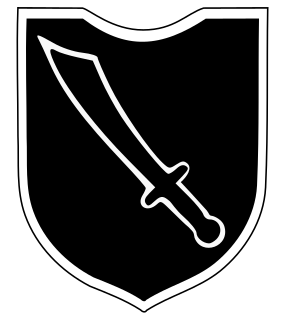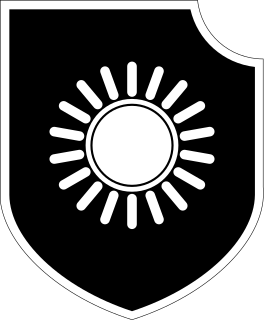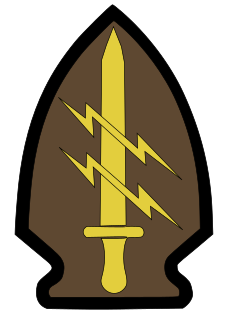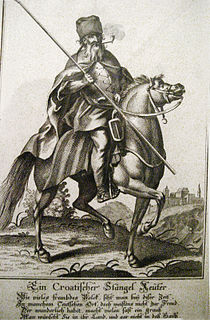 W
WThe 13th Waffen Mountain Division of the SS Handschar was a mountain infantry division of the Waffen-SS, an armed branch of the German Nazi Party that served alongside but was never formally part of the Wehrmacht during World War II. At the post-war Nuremberg trials, the Waffen-SS was declared to be a criminal organisation due to its major involvement in war crimes and crimes against humanity. From March to December 1944, the division fought a counter-insurgency campaign against communist-led Yugoslav Partisan resistance forces in the Independent State of Croatia, a fascist puppet state of Germany that encompassed almost all of modern-day Croatia, all of modern-day Bosnia and Herzegovina as well as parts of Serbia. It was given the title Handschar after a local fighting knife or sword carried by Ottoman policemen during the centuries that the region was part of the Ottoman Empire. It was the first non-Germanic Waffen-SS division, and its formation marked the expansion of the Waffen-SS into a multi-ethnic military force. Composed of Bosnian Muslims with some Catholic Croat soldiers and mostly German and Yugoslav Volksdeutsche officers and non-commissioned officers, it took an oath of allegiance to both Adolf Hitler and the Croatian leader Ante Pavelić.
 W
WThe 23rd Waffen Mountain Division of the SS Kama was a German mountain infantry division of the Waffen-SS, the armed wing of the German Nazi Party that served alongside but was never formally part of the Wehrmacht during World War II. At the post-war Nuremberg trials, the Waffen-SS was declared to be a criminal organisation due to its major involvement in war crimes and crimes against humanity. The division was composed of German officers and Bosnian Muslim soldiers. Named Kama after a small dagger used by Balkan shepherds, it was one of the thirty-eight divisions fielded by the Waffen-SS during World War II. Formed on 19 June 1944, it was built around a cadre from the 13th Waffen Mountain Division of the SS Handschar but did not reach its full strength and never saw action as a formation.
 W
WThe 24th Waffen Mountain Division of the SS "Karstjäger" was a German mountain infantry division of the Waffen-SS, the armed wing of the German Nazi Party that served alongside, but was never formally part of, the Wehrmacht during World War II. At the post-war Nuremberg trials, the Waffen-SS was declared to be a criminal organisation due to its major involvement in war crimes and crimes against humanity. Named Karstjäger, the formation was one of the 38 divisions fielded by the Waffen-SS. Formed on 18 July 1944 from the SS Volunteer Karstwehr Battalion, its nominal strength was never more than theoretical and the division was soon reduced to the Waffen Mountain (Karstjäger) Brigade of the SS. Throughout its existence as a battalion, division and brigade, it was primarily involved in fighting partisans in the Karst Plateau on the frontiers of Yugoslavia, Italy, and Austria; the mountainous terrain required specialised mountain troops and equipment.
 W
WThe 42. Home Guard Infantry Division, nicknamed the Devil's Division was an infantry division of the Royal Croatian Home Guard within the Austro-Hungarian Army which was active in World War I.
 W
WThe Armed Boats Squadron Dubrovnik was a volunteer unit of the Croatian Navy that ran the naval blockade during the siege of Dubrovnik which formed part of the Croatian War of Independence in 1991–1992. It consisted of 23 vessels, mostly of the runabout type, lightly armed and armoured. The unit was crucial in the defence of Dubrovnik, providing a resupply route for the Dubrovnik population and troops defending the besieged city. Boats assigned to the squadron transported approximately 6,000 troops and civilians, about 100 wounded and 2,000 tonnes of various cargo. A total of 117 personnel served with the squadron during the siege, suffering two fatalities.
 W
WThe Battle of Mursa was fought on 28 September 351 between the eastern Roman armies led by the Emperor Constantius II and the western forces supporting the usurper Magnentius. It took place at Mursa, near the Via Militaris in the province of Pannonia. The battle, one of the bloodiest in Roman history, was a pyrrhic victory for Constantius.
 W
WThe Triune Kingdom of Croatia, Slavonia and Dalmatia was part of Austria-Hungary during World War I. Its territory was administratively divided between the Austrian and Hungarian parts of the empire; Međimurje and Baranja were in the Hungarian part (Transleithania), the Kingdom of Croatia-Slavonia was a separate entity associated with the Hungarian Kingdom, Dalmatia and Istria were in the Austrian part (Cisleithania), while the town of Rijeka had semi-autonomous status.
 W
WCroatian Confraternity Bokelj Navy 809 is a non-profit association which was established in 1924 in Zagreb. It preserves the twelve century-long tradition of the Bokeljs, people originating from Boka Kotorska, who are mostly Croats, but include some Montenegrins. The Bokeljs lived along the bay under various authorities over the centuries, some of which were: the Byzantine Empire, the Kingdom of Duklja (Dioclea), the Serbian Empire, the Kingdom of Croatia-Hungary, the Kingdom of Bosnia, the Republic of Venice, the Habsburg Empire, Yugoslavia, and Montenegro). They were famous seamen, naval heroes and explorers. Their members include Ivan Visin, Matija Zmajević, Krsto Čorko, Tripun Luković, Petar Želalić and Božo Nikolić.
 W
WThe Military Frontier was a district of the Military Frontier, a territory in the Habsburg Monarchy, first during the period of the Austrian Empire and then during Austria-Hungary.
 W
WThe order of battle of the Croatian (SJP) Specialne Jedinice Policia in English: The Special Police Unit in 1991–1995 included up to 30 individual special forces units subordinated to the Ministry of the Interior. The special police was created around the Ministry of the Interior's existing airborne special forces unit following an open revolt of the Croatian Serbs against the Government of Croatia in August 1990. It further developed with the increasing involvement of the Yugoslav People's Army in the conflict, supporting the Croatian Serbs. The conflict escalated into the Croatian War of Independence in 1991. The special police took part in the first clashes of the war in Pakrac and at the Plitvice Lakes. As Croatia had no army, the 3,000-strong special forces became the country's most effective fighting force.
 W
WThe Croats, also known as Cravats or Crabats were 17th-century light cavalry forces in Central Europe, comparable to the hussars. The Croats were initially irregular units loosely organized in bands. The first regular Croat regiment was established in 1625.
 W
WThe Military Frontier was a borderland of the Habsburg Monarchy and later the Austrian and Austro-Hungarian Empire. It acted as the cordon sanitaire against incursions from the Ottoman Empire.
 W
WThe Royal Croatian Home Guard was the Croatian-Slavonian army section of the Royal Hungarian Landwehr, which existed from 1868 to 1918. The force was created by decree of the Croatian Parliament on December 5, 1868 as a result of the Croatian–Hungarian Settlement.
 W
WThe Seressaner were an Habsburg military police unit in Lika, Croatian Military Frontier. The name is derived from Saracens.
 W
WThe Siege of Varaždin was a siege in the Kingdom of Croatia. The war came as a result of Croatian, Slavonian and Hungarian noble diets electing different candidates for their kings, following the death of Louis II of Hungary at Battle of Mohacs.
 W
WThe Slavonian Military Frontier was a district of the Military Frontier, a territory in the Habsburg Monarchy, first during the period of the Austrian Empire and then during the Austro-Hungarian Monarchy. It was formed out of territories the Habsburgs conquered from the Ottoman Empire and included southern parts of Slavonia and Syrmia; today the area it covered is mostly in eastern Croatia, with its easternmost parts in northern Serbia.
 W
WTrenck's Pandurs were a light infantry unit of the Habsburg Monarchy, raised by Baron Franz von der Trenck under a charter issued by Maria Theresa of Austria in 1741. The unit was largely composed of volunteers from the Kingdom of Slavonia and Slavonian Military Frontier, and named after security guards otherwise employed to maintain public order. The Pandurs were presented to the empress in May 1741—with the unit's military band—earning them a claim of pioneering martial music in Europe. The Pandurs did not use uniforms and had an overall oriental/Ottoman appearance. The original organization of the unit was retained until 1745, when it transformed into a regiment. Trenck was relieved of command in 1746 and imprisoned in Spielberg Castle, where he died in 1749. The unit ultimately transformed into the 53rd Infantry Regiment, headquartered in Zagreb, until it was disbanded in 1919. The regiment's commemorative medals bear Trenck's image wearing Pandur attire.
 W
WThe Uskoks were irregular soldiers in Habsburg Croatia that inhabited areas on the eastern Adriatic coast and surrounding territories during the Ottoman wars in Europe. Etymologically, the word uskoci itself means "the ones who jumped in" in South Slavic languages Bands of Uskoks fought a guerrilla war against the Ottomans, and they formed small units and rowed swift boats. Since the uskoks were checked on land and were rarely paid their annual subsidy, they resorted to acts of piracy.